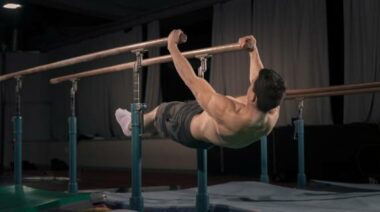Squats and hip thrusts have been used by strength and conditioning coaches for years to develop explosive power. There’s no secret that this training approach works to build strong athletes, but until now, there has been a dearth of research in this area of science.
The Journal of Strength and Conditioning Research recently published the first longitudinal study to compare performance improvements in hip thrusts versus squats.
Hip Thrusts Develop Sprinting Power
Researchers hypothesized that barbell hip thrusts would be better than squats for improving horizontal force production, thereby enhancing performance in athletic movements requiring a horizontal force vector, such as horizontal jumping and sprinting.
According to the study’s first author, Bret Contreras, squats poorly activate the hamstrings and do not maximally activate the glutes, which are critical muscle groups for powerful sprinting. In a squat, the glutes are fired up during the concentric action – when you explode out of the hole. Glute activation decreases near the top when the athlete is in a more upright position, which is characteristic of applying force into the ground while running.
The study was comprised of male teenage athletes and consisted of 2 training sessions per week for 6 weeks in a periodized fashion. One group performed only front squats, and another group performed only hip thrusts. Pre- and post-test performance measures included 10-meter acceleration, 20-meter acceleration, vertical jump, maximum isometric midthigh pull, 3-rep-max front squat, and 3-rep-max hip thrust.
Results showed that among teenage male athletes, hip thrusts are more effective than front squats at improving sprinting acceleration, max isometric mid-thigh pull force, and max hip thrust strength. However, front squats are more effective than hip thrusts at improving vertical jump max and front squat strength.
In addition, athletes who performed the hip thrust gained half as much front squat strength as those who only performed front squats, and vice versa. This is an important finding, as it demonstrates that hip extension exercises transfer to other lifts and points to the possibility that strength in one lift can be maintained during times of injury by performing assistance lifts.
Limitations and Future Directions
Researchers note that different periodization protocols and training durations, other movements like back squats and deadlifts, and additional performance outcomes should be tested to add to the literature.
This study may lead coaches to consider making the hip thrust a more prominent component of a strength-building program. Contreras suggests that results could support periodizing training around maximizing vertical and horizontal force production performance.
More research is needed to duplicate the findings on athletes from other sports or female trainees, but this is the first study of its kind to put evidence behind anecdotal theory. In sports, fast equals strong. For performance-based athletes, consider making the hip thrust, along with the squat, a staple in your training routine.
Headline photo courtesy of Craig Marker.






